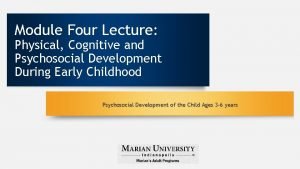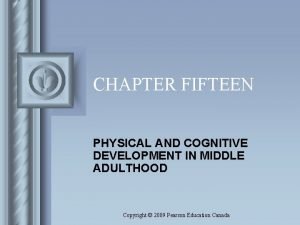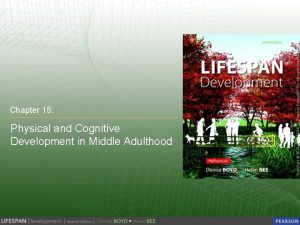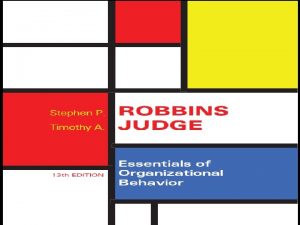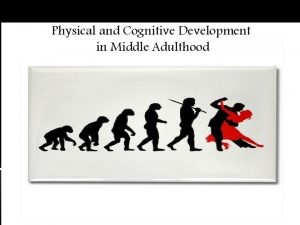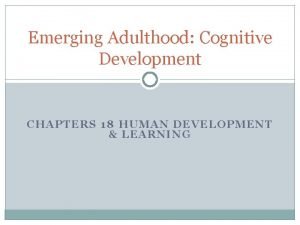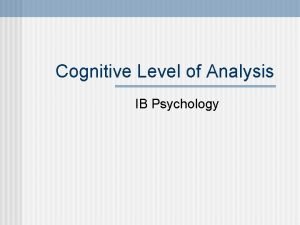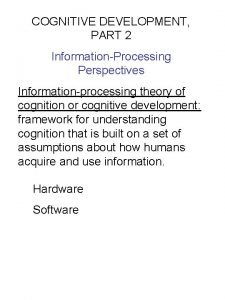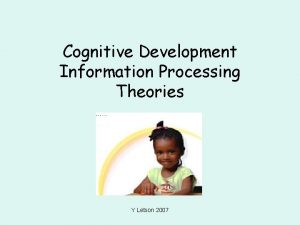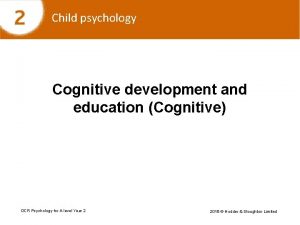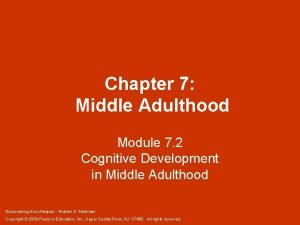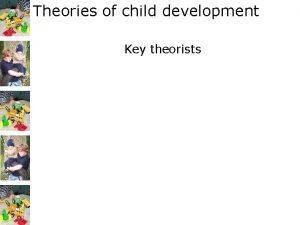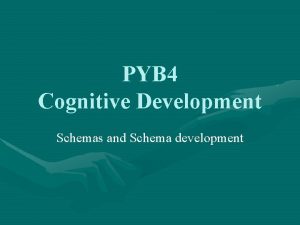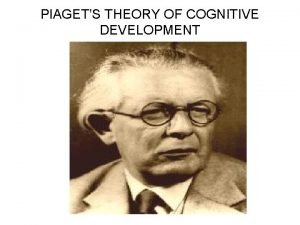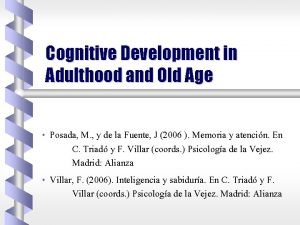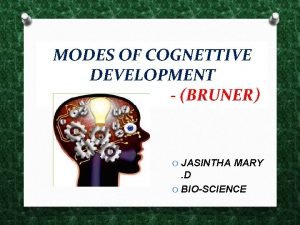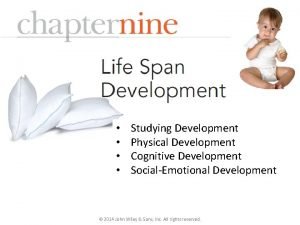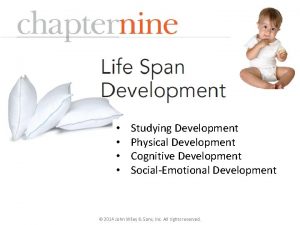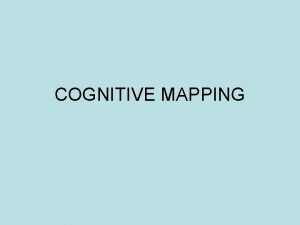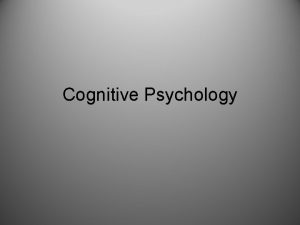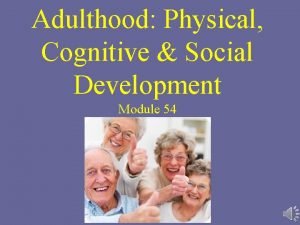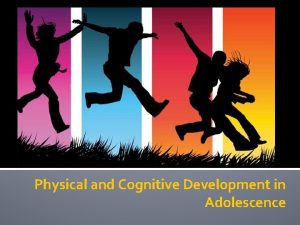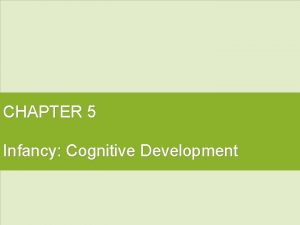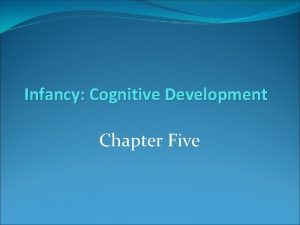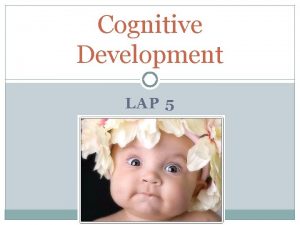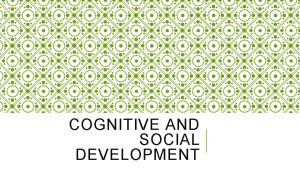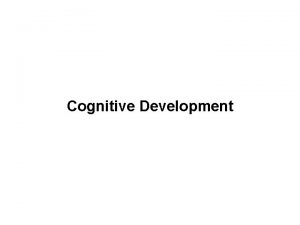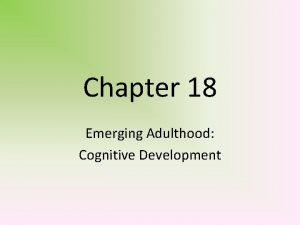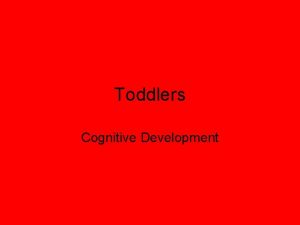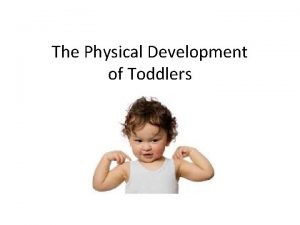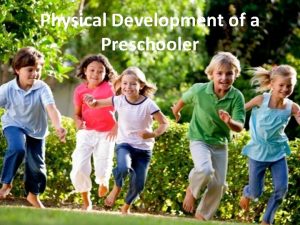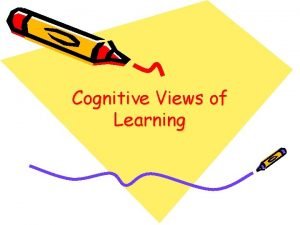Lecture Overview Studying Development Physical Development Cognitive Development































- Slides: 31

Lecture Overview • Studying Development • Physical Development • Cognitive Development • Social-Emotional Development ©John Wiley & Sons, Inc. 2010

Studying Development • Developmental Psychology: studies agerelated changes in behavior & mental processes from conception to death ©John Wiley & Sons, Inc. 2010

©John Wiley & Sons, Inc. 2010

Studying Development– Key Theoretical Debates • Nature vs. Nurture: heredity vs. environment • Continuity vs. Stages: continuous & gradual vs. periods of abrupt change followed by periods of little change • Stability vs. Change: characteristics maintained vs. characteristics vary over time ©John Wiley & Sons, Inc. 2010

Studying Development (Continued) • What position on these three debates is most correct? Most psychologists support the interactionist perspective, which recently evolved into the biopsychosocial model. Biological Social ©John Wiley & Sons, Inc. 2010 Psychological

Pause & Reflect: Critical Thinking Behaviorist John Watson said: “Give me a dozen healthy infants, well-formed, & my own specified world to bring them up in, & I'll guarantee to take anyone at random & train them to become any type of specialist I might select-- doctor, lawyer, artist, merchant -chief, &, yes, even beggar man & thief, regardless of his talents, penchants, tendencies, abilities, vocations, & race of his ancestors. " (Boakes, 1984, pp. 226) Do you agree? Why or why not? ©John Wiley & Sons, Inc. 2010

Cultural Guidelines for Developmental Research • Culture is a very important determinant. • Development cannot be studied outside its socio-cultural context. • Each culture’s ethno-theories are important determinants. • Culture is largely invisible to participants. ©John Wiley & Sons, Inc. 2010

Physical Development— The Moment of Conception ©John Wiley & Sons, Inc. 2010

Physical Development— Three Stages of Prenatal Development 1. Germinal Period: conception to uterine implantation 2. Embryonic Period: uterine implantation through the eighth week 3. Fetal Period: eighth week until birth ©John Wiley & Sons, Inc. 2010

Physical Development— Three Stages of Prenatal Development ©John Wiley & Sons, Inc. 2010

Physical Development— Hazards to Prenatal Development • Teratogens: environmental agents that cause damage during prenatal development • Categories of teratogens: – Legal & illegal drugs – Diseases & malnutrition – Exposure to X-rays & stress ©John Wiley & Sons, Inc. 2010

Physical Development— Hazards to Prenatal Development ©John Wiley & Sons, Inc. 2010

Physical Development— Early Childhood • Three key areas of early childhood development: – Brain – Motor – Sensory/perceptual ©John Wiley & Sons, Inc. 2010

Physical Development— Prenatal Brain Development ©John Wiley & Sons, Inc. 2010

Physical Development— Brain Development • As a child develops, his or her neurons grow in size & the number of dendrites & axons increase. ©John Wiley & Sons, Inc. 2010

Lifespan Changes in Body Proportions ©John Wiley & Sons, Inc. 2010

Physical Development—Early Childhood • Milestones in motor development ©John Wiley & Sons, Inc. 2010

Physical Development— Sensory & Perceptual Development • Smell, taste, touch, & hearing are well developed at birth. • Vision is poorly developed at birth. ©John Wiley & Sons, Inc. 2010

Cognitive Development • Jean Piaget believed infants begin at a cognitively “primitive” level & progress in distinct stages. • Piaget’s schemas are the most basic unit of intellect, which act as patterns that organize interactions with the environment. ©John Wiley & Sons, Inc. 2010

Cognitive Development (Continued) • Schemas grow & change due to: – Assimilation: absorbing new information into existing schemas – Accommodation: adjusting old schemas or developing new ones to better fit with new information ©John Wiley & Sons, Inc. 2010

Cognitive Development— • • Sensorimotor: birth-2 years Preoperational: 2 -7 years Concrete Operational: 7 -11 years Formal Operational: 11 years & up ©John Wiley & Sons, Inc. 2010

©John Wiley & Sons, Inc. 2010

©John Wiley & Sons, Inc. 2010

Assessing Piaget’s Theory— Two Major Criticisms 1. Underestimated abilities (e. g. , newborns can imitate facial expressions) 2. Underestimated genetic & cultural influences ©John Wiley & Sons, Inc. 2010

Social-Emotional Development • Social Development • Attachment: strong affectional bond with special others that endures over time – Harlow’s work with monkeys--feeding or contact comfort? ©John Wiley & Sons, Inc. 2010

Social-Emotional Development— Three Levels of Attachment • Ainsworth’s strange situation procedure identified three types of attachment in children: 1. Securely Attached Child stays close to mother, shows moderate distress when separated, & is happy when mother returns. ©John Wiley & Sons, Inc. 2010

Three Levels of Attachment (Continued) 2. Avoidant: Child treats mother & stranger the same & rarely cries when mother leaves. 3. Anxious/Ambivalent: Child is upset when mother leaves. When mother returns, child seeks closeness, but also squirms away. ©John Wiley & Sons, Inc. 2010

Pause & Reflect: Psychology at Work • Research suggests the attachment patterns we develop as infants may carry over into similar patterns in our adult romantic relationships. ©John Wiley & Sons, Inc. 2010

Social-Emotional Development— Baumrind’s Three Parenting Styles 1. Permissive (Permissive. Neglectful & Permissive. Indulgent) 2. Authoritarian 3. Authoritative • Identified by degree of control/demandingness (C) & warmth/ responsiveness (W) ©John Wiley & Sons, Inc. 2010

Social-Emotional Development— Baumrind’s Three Parenting Styles 1. Permissive a. Permissive-Neglectful Few limits or control (Lo C), little warmth or responsiveness (Lo W) b. Permissive-Indulgent Few limits or control (Lo C), high warmth & responsiveness (Hi W) ©John Wiley & Sons, Inc. 2010

Baumrind’s Three Parenting Styles (Continued) 2. Authoritarian Highly controlling (Hi C), little warmth or responsiveness (Lo W) 3. Authoritative Set & enforce firm limits (Hi C), high warmth or responsiveness (Hi W) ©John Wiley & Sons, Inc. 2010 Study Tip: • Two “Rs” in Autho. Rita. Rian = “Rigid Ruler!” • Two “Ts” in Au. Thori. Tative = “Tender Teacher!”
 Cognitive development early adulthood
Cognitive development early adulthood Physical and cognitive development in early adulthood
Physical and cognitive development in early adulthood Define physical cognitive and psychosocial development
Define physical cognitive and psychosocial development Cognitive and non cognitive religious language
Cognitive and non cognitive religious language 01:640:244 lecture notes - lecture 15: plat, idah, farad
01:640:244 lecture notes - lecture 15: plat, idah, farad What is physical storage media
What is physical storage media Denny's model of physical and cognitive ageing
Denny's model of physical and cognitive ageing Denny's model of physical and cognitive ageing
Denny's model of physical and cognitive ageing The investment of an employee's physical cognitive
The investment of an employee's physical cognitive Physical science lecture notes
Physical science lecture notes Cognitive development for middle adulthood
Cognitive development for middle adulthood Cognitive development in middle and late childhood
Cognitive development in middle and late childhood Ap psych schema
Ap psych schema Intellectual development in older adulthood
Intellectual development in older adulthood Gerome bruner
Gerome bruner Information processing theory summary
Information processing theory summary Cognitive development in emerging adulthood
Cognitive development in emerging adulthood Piaget equilibrium
Piaget equilibrium Intellectual development characteristics
Intellectual development characteristics Information processing theory of cognitive development
Information processing theory of cognitive development Information processing theory of cognitive development
Information processing theory of cognitive development Cognitive development and education
Cognitive development and education Middle adulthood cognitive development
Middle adulthood cognitive development Bandura theory
Bandura theory Schema cognitive development
Schema cognitive development Outline piaget's theory of cognitive development
Outline piaget's theory of cognitive development Early childhood is __________ for language learning
Early childhood is __________ for language learning Cognitive development in old age
Cognitive development in old age Conclusion of cognitive development
Conclusion of cognitive development Child development: an active learning approach 4th edition
Child development: an active learning approach 4th edition Piaget's preoperational stage
Piaget's preoperational stage Bruner's theory of cognitive development
Bruner's theory of cognitive development


